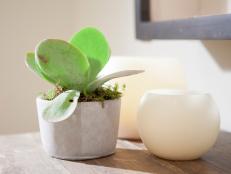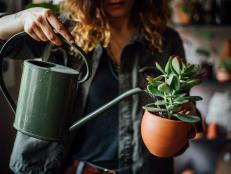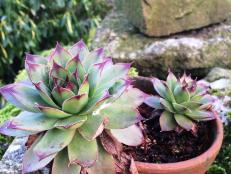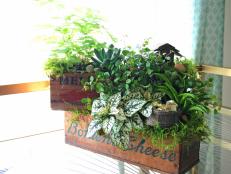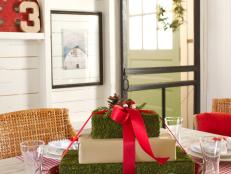Succulent Centerpieces

Colorful succulent plants can take a little of the stress out of holiday entertaining. Forget about watering these arrangements and you'll be fine. These fleshy-leaved plants hold moisture in their stems, roots or leaves (immersion in water will cause the stems to rot). So add drama and interest to your holiday table with these succulent ideas:

1. Use any type of container as long as the anchoring medium will hold the stems in place. This is easily done with floral foam, which is available in any floral supply shop. Or, you can use aquarium gravel, which conforms to any enclosed shape, comes in many colors and is especially nice at the base of clear glass bowls. The plants are heavy, however, so the base must be somewhat weighty or the arrangement will be top-heavy.
2. Once you've chosen your container and anchoring medium, wash the cut plants that were cultivated outdoors. This will clean them up and get rid of lingering bugs. Submerge them in a large bucket containing water, rubbing alcohol, a little liquid soap and cayenne pepper — bugs don't like cayenne pepper. One gardener swears fresh garlic buzzed with water in a blender is also quite effective.
3. Use low arrangements to create a centerpiece that won't block the view of your guests. This arrangement calls for a very shallow bowl filled with floral foam.

4. Prepare cut succulents for the arrangement. Because they have such heavy, thick stems, anchor them with toothpicks, bamboo skewers or wires.
5. Begin working in threes with green-hued plants, like kalanchoe or crassula. There are many solid greens to choose from. Place each of the three stems adjacent to each other in the anchoring medium to form the points of a slightly lopsided triangle.

6. Following that pattern, begin to fill in with more spectacular things with interesting colors, forms or textures — Kalanchoe thyrsiflora, commonly called flapjacks or paddle plant, aeoniums (Aeonium), echeverias (members of the genus Echeveria, which includes hens-and-chicks). Echeverias come in many colors and forms, and are characterized by large rosettes of thick leaves.
7. When you have the bowl nearly covered, add some accent plants for added texture and interest. One favorite is wandering Jew (Tradescantia pallida "Purpurea," also called purple heart), valued for its spectacular purple color. This plant has a very soft stem, so don't ram a toothpick in there, a small wire will do. It grows easily in the house or out; in California it can get pretty rambunctious in the garden. Another good plant for interest and excitement is Portulacaria afra, often called elephant food. In Africa, elephants devour large bushes of this for its lemony taste. Here the variegated yellow and green small leaves and dark red angular stems contrast well with the large fleshy leaves of the echeveria.

8. When the arrangement is nearly finished, rotate it. If you can see the foam, plug the hole. A good plant for filling holes is Euphorbia tirucalli "Sticks on Fire." Although it has a poisonous sap, it's very useful for arrangements. As a precaution, immerse the cut stems immediately in water. This stops the sap from flowing and causes the ends to seal up — as do those of any cut succulent. It's a fabulous plant, not only for the color, but for the twiggy-ness of it. Cold weather causes it to turn bright red — hence the name. All the plants known as euphorbias (and there are about 2,000 of them) have this poisonous sap, so handle with care.

9. Use tall arrangements as a focal point in a room. With tall vases, match the plant material with the height of the container. So when arranging, establish the height first with the plants and then place shorter plants in front. One very useful and somewhat spectacular euphorbia for adding height is the red and green trigona. In the garden it grows fairly quickly to about 6 feet tall and is one of the more interesting tall, stiff background plants — invaluable for very large arrangements. Sansevieria leaves are also good for height. They come in several forms and color patterns, some will grow to 3 feet tall and are not poisonous.
Mahogany echeveria is a focal point of this tall arrangement. The plant is anchored with three toothpicks because it is quite heavy. Here Crassula muscosa is used as a filler to soften things a bit, but there are many other succulents that will do as well. Small clumps of succulents can be helped to stand by wrapping a length of floral wire around the last 3 or 4 inches with a "tail" of wire extending. Stick only the wire into the gravel and the rest can wave or droop as you like. Complete the arrangement by plugging in holes with filler or accent plants, such as the "Sticks on Fire" used here. Remember, contrast is good.

10. Your finished product should last at least a month, but it will look better if you occasionally spritz it with water. Before the month is out, you may notice that the various plants are forming roots. You may want to take it apart and plant the various pieces. While some will freeze outside, many will grow inside or out. If you go away for a month and it doesn't rain, they may look a little sad, but they generally won't die. Throw some water on them and watch them say thank you!
—Judy Casanova is an artist, xeriscaper and owner of Desert Succulent Creations, www.desertsucculents.com, in Claremont, Calif.
—photos by Adam Brick






